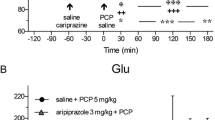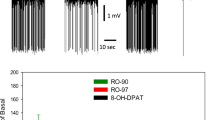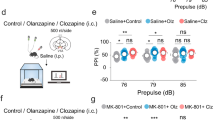Abstract
Introduction
The atypical antipsychotic drug, quetiapine (QTP), is effective in schizophrenia and mood disorders, but induces seizures compared to typical antipsychotics.
Methods
To explore the mechanisms of action of QTP, we determined its effects on extracellular levels of norepinephrine, dopamine, serotonin, gamma-aminobutyric acid (GABA), and glutamate in the medial prefrontal cortex (mPFC) using microdialysis, and neuronal firing in the ventral tegmental area (VTA), locus coeruleus (LC), dorsal raphe nucleus (DRN), and mediodorsal thalamic nucleus (MTN) by telemetry in freely moving rats.
Results
QTP (10 and 30 mg/kg, i.p.) activated neuronal firing in the VTA, LC, and MTN without affecting that in the DRN. QTP increased extracellular levels of norepinephrine, dopamine, and glutamate without affecting serotonin or GABA levels in the mPFC. The stimulatory effects of QTP on norepinephrine and dopamine were mediated by positive alpha-amino-3-hydroxy-5-methyl-4-isoxazolepropionic acid (AMPA)/glutamatergic and negative GABA-mediated NMDA/glutamatergic regulation.
Discussion
The dopaminergic terminal projecting from the VTA received inhibitory GABA-mediated NMDA/glutamatergic regulation, but not stimulatory AMPA/glutamatergic regulation. However, both dopaminergic and noradrenergic terminals from the LC received stimulatory AMPA/glutamatergic regulation from the MTN, but not inhibitory GABA-mediated NMDA/glutamatergic regulation. These findings correlating neuronal activities in nuclei with neurotransmitter release suggested that the effects of QTP on neurotransmission in the mPFC depend on activated neuronal projections located outside the mPFC. Furthermore, positive interaction between LC and MTN afferents are potentially important in the pharmacological mechanisms of neurotransmitter regulation by QTP and hint at mechanisms underlying the atypical profile of this drug for treatment of schizophrenia and as a mood stabilizer and proconvulsive agent.









Similar content being viewed by others
References
Abekawa T, Ito K, Koyama T (2006) Role of the simultaneous enhancement of NMDA and dopamine D1 receptor-mediated neurotransmission in the effects of clozapine on phencyclidine-induced acute increases in glutamate levels in the rat medial prefrontal cortex. Naunyn Schmiedebergs Arch Pharmacol 374:177–193
Adams BW, Moghaddam B (2001) Effect of clozapine, haloperidol, or M100907 on phencyclidine-activated glutamate efflux in the prefrontal cortex. Biol Psychiatry 50:750–757
Aghajanian GK, Foote WE, Sheard MH (1970) Action of psychotogenic drugs on single midbrain raphe neurons. J Pharmacol Exp Ther 171:178–187
Aghajanian GK, Cedarbaum JM, Wang RY (1977) Evidence for norepinephrine-mediated collateral inhibition of locus coeruleus neurons. Brain Res 136:570–577
Alper K, Schwartz KA, Kolts RL, Khan A (2007) Seizure incidence in psychopharmacological clinical trials: an analysis of Food and Drug Administration (FDA) summary basis of approval reports. Biol Psychiatry 62:345–354
Amargos-Bosch M, Adell A, Artigas F (2007) Antipsychotic drugs reverse the AMPA receptor-stimulated release of 5-HT in the medial prefrontal cortex. J Neurochem 102:550–561
Assie MB, Ravailhe V, Faucillon V, Newman-Tancredi A (2005) Contrasting contribution of 5-hydroxytryptamine 1A receptor activation to neurochemical profile of novel antipsychotics: frontocortical dopamine and hippocampal serotonin release in rat brain. J Pharmacol Exp Ther 315:265–272
Bertram EH, Zhang D, Williamson JM (2008) Multiple roles of midline dorsal thalamic nuclei in induction and spread of limbic seizures. Epilepsia 49:256–268
Bunney BS, Walters JR, Roth RH, Aghajanian GK (1973) Dopaminergic neurons: effect of antipsychotic drugs and amphetamine on single cell activity. J Pharmacol Exp Ther 185:560–571
Bymaster FP, Rasmussen K, Calligaro DO, Nelson DL, DeLapp NW, Wong DT et al (1997) In vitro and in vivo biochemistry of olanzapine: a novel, atypical antipsychotic drug. J Clin Psychiatry 58(Suppl 10):28–36
Celada P, Puig MV, Casanovas JM, Guillazo G, Artigas F (2001) Control of dorsal raphe serotonergic neurons by the medial prefrontal cortex: involvement of serotonin-1A, GABA(A), and glutamate receptors. J Neurosci 21:9917–9929
Cotman CW, Monaghan DT (1986) Anatomical organization of excitatory amino acid receptors and their properties. Adv Exp Med Biol 203:237–252
Dando TM, Keating GM (2006) Spotlight on quetiapine in acute mania and depression associated with bipolar disorder. CNS Drugs 20:429–431
Denys D, Klompmakers AA, Westenberg HG (2004) Synergistic dopamine increase in the rat prefrontal cortex with the combination of quetiapine and fluvoxamine. Psychopharmacology (Berl) 176:195–203
Devoto P, Flore G (2006) On the origin of cortical dopamine: is it a co-transmitter in noradrenergic neurons? Curr Neuropharmacol 4:115–125
Devoto P, Flore G, Saba P, Fa M, Gessa GL (2005) Stimulation of the locus coeruleus elicits noradrenaline and dopamine release in the medial prefrontal and parietal cortex. J Neurochem 92:368–374
Gessa GL, Devoto P, Diana M, Flore G, Melis M, Pistis M (2000) Dissociation of haloperidol, clozapine, and olanzapine effects on electrical activity of mesocortical dopamine neurons and dopamine release in the prefrontal cortex. Neuropsychopharmacology 22:642–649
Haddjeri N, de Montigny C, Blier P (1999) Modulation of the firing activity of rat serotonin and noradrenaline neurons by (+/−)pindolol. Biol Psychiatry 45:1163–1169
Harrison PJ, Weinberger DR (2005) Schizophrenia genes, gene expression, and neuropathology: on the matter of their convergence. Mol Psychiatry 10:40–68 image 45
Ichikawa J, Kuroki T, Dai J, Meltzer HY (1998) Effect of antipsychotic drugs on extracellular serotonin levels in rat medial prefrontal cortex and nucleus accumbens. Eur J Pharmacol 351:163–171
Ichikawa J, Li Z, Dai J, Meltzer HY (2002) Atypical antipsychotic drugs, quetiapine, iloperidone, and melperone, preferentially increase dopamine and acetylcholine release in rat medial prefrontal cortex: role of 5-HT1A receptor agonism. Brain Res 956:349–357
Jay TM, Thierry AM, Wiklund L, Glowinski J (1992) Excitatory amino acid pathway from the hippocampus to the prefrontal cortex. Contribution of AMPA receptors in hippocampo-prefrontal cortex transmission. Eur J Neurosci 4:1285–1295
Jones LS, Gauger LL, Davis JN (1985) Anatomy of brain alpha 1-adrenergic receptors: in vitro autoradiography with [125I]-heat. J Comp Neurol 231:190–208
Kapur S, VanderSpek SC, Brownlee BA, Nobrega JN (2003) Antipsychotic dosing in preclinical models is often unrepresentative of the clinical condition: a suggested solution based on in vivo occupancy. J Pharmacol Exp Ther 305:625–631
Keating GM, Robinson DM (2007) Spotlight on quetiapine in bipolar depression. CNS Drugs 21:695–697
Kuroda M, Yokofujita J, Murakami K (1998) An ultrastructural study of the neural circuit between the prefrontal cortex and the mediodorsal nucleus of the thalamus. Prog Neurobiol 54:417–458
Lambe EK, Goldman-Rakic PS, Aghajanian GK (2000) Serotonin induces EPSCs preferentially in layer V pyramidal neurons of the frontal cortex in the rat. Cereb Cortex 10:974–980
Liegeois JF, Ichikawa J, Meltzer HY (2002) 5-HT(2A) receptor antagonism potentiates haloperidol-induced dopamine release in rat medial prefrontal cortex and inhibits that in the nucleus accumbens in a dose-dependent manner. Brain Res 947:157–165
Lim EP, Verma V, Nagarajah R, Dawe GS (2007) Propranolol blocks chronic risperidone treatment-induced enhancement of spatial working memory performance of rats in a delayed matching-to-place water maze task. Psychopharmacology (Berl) 191:297–310
Lopez-Gil X, Babot Z, Amargos-Bosch M, Sunol C, Artigas F, Adell A (2007) Clozapine and haloperidol differently suppress the MK-801-increased glutamatergic and serotonergic transmission in the medial prefrontal cortex of the rat. Neuropsychopharmacology 32:2087–2097
Lorrain DS, Baccei CS, Bristow LJ, Anderson JJ, Varney MA (2003) Effects of ketamine and N-methyl-D-aspartate on glutamate and dopamine release in the rat prefrontal cortex: modulation by a group II selective metabotropic glutamate receptor agonist LY379268. Neuroscience 117:697–706
Martin-Ruiz R, Puig MV, Celada P, Shapiro DA, Roth BL, Mengod G et al (2001) Control of serotonergic function in medial prefrontal cortex by serotonin-2A receptors through a glutamate-dependent mechanism. J Neurosci 21:9856–9866
Meltzer HY, Li Z, Kaneda Y, Ichikawa J (2003) Serotonin receptors: their key role in drugs to treat schizophrenia. Prog Neuropsychopharmacol Biol Psychiatry 27:1159–1172
Mitelman SA, Byne W, Kemether EM, Hazlett EA, Buchsbaum MS (2005) Metabolic disconnection between the mediodorsal nucleus of the thalamus and cortical Brodmann’s areas of the left hemisphere in schizophrenia. Am J Psychiatry 162:1733–1735
Moghaddam B, Adams B, Verma A, Daly D (1997) Activation of glutamatergic neurotransmission by ketamine: a novel step in the pathway from NMDA receptor blockade to dopaminergic and cognitive disruptions associated with the prefrontal cortex. J Neurosci 17:2921–2927
Newman-Tancredi A, Gavaudan S, Conte C, Chaput C, Touzard M, Verriele L et al (1998) Agonist and antagonist actions of antipsychotic agents at 5-HT1A receptors: a [35S]GTPgammaS binding study. Eur J Pharmacol 355:245–256
Okada M, Zhu G, Yoshida S, Hirose S, Kaneko S (2004) Protein kinase associated with gating and closing transmission mechanisms in temporoammonic pathway. Neuropharmacology 47:485–504
Okada M, Yoshida S, Zhu G, Hirose S, Kaneko S (2005) Biphasic actions of topiramate on monoamine exocytosis associated with both soluble N-ethylmaleimide-sensitive factor attachment protein receptors and Ca2+-induced Ca2+-releasing systems. Neuroscience 134:233–246
Okada M, Kawata Y, Mizuno K, Wada K, Kondo T, Kaneko S (1998) Interaction between Ca2+, K+, carbamazepine and zonisamide on hippocampal extracellular glutamate monitored with a microdialysis electrode. Br J Pharmacol 124:1277–1285
Okada M, Nutt DJ, Murakami T, Zhu G, Kamata A, Kawata Y et al (2001) Adenosine receptor subtypes modulate two major functional pathways for hippocampal serotonin release. J Neurosci 21:628–640
Okada M, Zhu G, Hirose S, Ito KI, Murakami T, Wakui M et al (2003) Age-dependent modulation of hippocampal excitability by KCNQ-channels. Epilepsy Res 53:81–94
Palacios JM, Hoyer D, Cortes R (1987) Alpha 1-adrenoceptors in the mammalian brain: similar pharmacology but different distribution in rodents and primates. Brain Res 419:65–75
Pan WH, Yang SY, Lin SK (2004) Neurochemical interaction between dopaminergic and noradrenergic neurons in the medial prefrontal cortex. Synapse 53:44–52
Pira L, Mongeau R, Pani L (2004) The atypical antipsychotic quetiapine increases both noradrenaline and dopamine release in the rat prefrontal cortex. Eur J Pharmacol 504:61–64
Price JL (1999) Prefrontal cortical networks related to visceral function and mood. Ann N Y Acad Sci 877:383–396
Pudovkina OL, Kawahara Y, de Vries J, Westerink BH (2001) The release of noradrenaline in the locus coeruleus and prefrontal cortex studied with dual-probe microdialysis. Brain Res 906:38–45
Richelson E, Souder T (2000) Binding of antipsychotic drugs to human brain receptors focus on newer generation compounds. Life Sci 68:29–39
Rowley HL, Needham PL, Kilpatrick IC, Heal DJ (2000) A comparison of the acute effects of zotepine and other antipsychotics on rat cortical dopamine release, in vivo. Naunyn Schmiedebergs Arch Pharmacol 361:187–192
Siever LJ, Davis KL (2004) The pathophysiology of schizophrenia disorders: perspectives from the spectrum. Am J Psychiatry 161:398–413
Small JG, Hirsch SR, Arvanitis LA, Miller BG, Link CG (1997) Quetiapine in patients with schizophrenia. A high- and low-dose double-blind comparison with placebo. Seroquel Study Group. Arch Gen Psychiatry 54:549–557
Sparshatt A, Jones S, Taylor D (2008) Quetiapine: dose–response relationship in schizophrenia. CNS Drugs 22:49–68 discussion 69–72
Sprouse JS, Reynolds LS, Braselton JP, Rollema H, Zorn SH (1999) Comparison of the novel antipsychotic ziprasidone with clozapine and olanzapine: inhibition of dorsal raphe cell firing and the role of 5-HT1A receptor activation. Neuropsychopharmacology 21:622–631
Svensson TH (2000) Dysfunctional brain dopamine systems induced by psychotomimetic NMDA-receptor antagonists and the effects of antipsychotic drugs. Brain Res Brain Res Rev 31:320–329
Van Eden CG, Hoorneman EM, Buijs RM, Matthijssen MA, Geffard M, Uylings HB (1987) Immunocytochemical localization of dopamine in the prefrontal cortex of the rat at the light and electron microscopical level. Neuroscience 22:849–862
van Veldhuizen MJ, Feenstra MG, Boer GJ, Westerink BH (1990) Microdialysis studies on cortical noradrenaline release: basic characteristics, significance of extracellular calcium and massive post-mortem increase. Neurosci Lett 119:233–236
Volonte M, Monferini E, Cerutti M, Fodritto F, Borsini F (1997) BIMG 80, a novel potential antipsychotic drug: evidence for multireceptor actions and preferential release of dopamine in prefrontal cortex. J Neurochem 69:182–190
Waterhouse BD, Lin CS, Burne RA, Woodward DJ (1983) The distribution of neocortical projection neurons in the locus coeruleus. J Comp Neurol 217:418–431
Weikop P, Kehr J, Scheel-Kruger J (2004) The role of alpha1- and alpha2-adrenoreceptors on venlafaxine-induced elevation of extracellular serotonin, noradrenaline and dopamine levels in the rat prefrontal cortex and hippocampus. J Psychopharmacol 18:395–403
Werkman TR, Olijslagers JE, Perlstein B, Jansen AH, McCreary AC, Kruse CG et al (2004) Quetiapine increases the firing rate of rat substantia nigra and ventral tegmental area dopamine neurons in vitro. Eur J Pharmacol 506:47–53
Yonezawa Y, Kuroki T, Kawahara T, Tashiro N, Uchimura H (1998) Involvement of gamma-aminobutyric acid neurotransmission in phencyclidine-induced dopamine release in the medial prefrontal cortex. Eur J Pharmacol 341:45–56
Young KA, Holcomb LA, Yazdani U, Hicks PB, German DC (2004) Elevated neuron number in the limbic thalamus in major depression. Am J Psychiatry 161:1270–1277
Zhang W, Perry KW, Wong DT, Potts BD, Bao J, Tollefson GD et al (2000) Synergistic effects of olanzapine and other antipsychotic agents in combination with fluoxetine on norepinephrine and dopamine release in rat prefrontal cortex. Neuropsychopharmacology 23:250–262
Zhu G, Okada M, Uchiyama D, Ohkubo T, Yoshida S, Kaneko S (2004) Hyperactivity of endoplasmic reticulum associated exocytosis mechanism contributes to acute phencyclidine intoxication. J Pharmacol Sci 95:214–227
Zhu G, Okada M, Yoshida S, Ueno S, Mori F, Takahara T et al (2008) Rats harboring S284L Chrna4 mutation show attenuation of synaptic and extrasynaptic GABAergic transmission and exhibit the nocturnal frontal lobe epilepsy phenotype. J Neurosci 28:12465–12476
Acknowledgments
This study was supported by a grant-in-aid for Scientific Research from the Japanese Ministry of Education, Science and Culture (18390316 and 18659330), a grant from the Mitsubishi Pharma Research Foundation, and a grant from the Japan Epilepsy Research Foundation.
Conflict of interest statement
The authors state no conflict of interest.
Author information
Authors and Affiliations
Corresponding author
Rights and permissions
About this article
Cite this article
Yamamura, S., Ohoyama, K., Hamaguchi, T. et al. Effects of quetiapine on monoamine, GABA, and glutamate release in rat prefrontal cortex. Psychopharmacology 206, 243–258 (2009). https://doi.org/10.1007/s00213-009-1601-9
Received:
Accepted:
Published:
Issue Date:
DOI: https://doi.org/10.1007/s00213-009-1601-9




